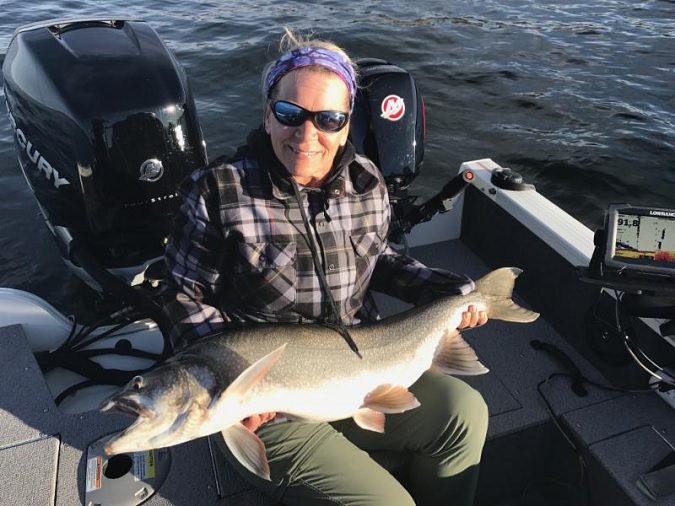Finding and catching fish on an unfamiliar body of water can be a challenge, but with the right mindset and strategies, it can also produce great fishing. “Whether you’re after lake trout, walleyes, bass or bluegills, the most important thing is not getting stuck in a rut and expecting fish in the new lake to behave exactly like those in your home waters,” says veteran trout and salmon guide Bernie Keefe.

“Even though you’re targeting the same species, everything else can change when you travel from one lake to another,” he adds.
Case in point: Keefe recently tested the waters of an unfamiliar lake trout fishery a long cast from his home base on Colorado’s Lake Granby.
“Productive structure was similar, trending toward rocky points, humps and ridges,” he recalls. “But key depths were completely different. On Granby, we fish relatively shallow. Thirty to 40 feet is common and 60 feet is deep. Water temperatures in the new lake were warmer, however, so the best bite was from 85 to more than 120 feet.”
Top presentations also differed. “The fish hit tube jigs in both lakes,” says Keefe. “But right now, Granby’s lakers like a fast-paced, 6-inch lift and drop. In the other lake, the trout wouldn’t hit anything that wasn’t deadsticked in a perfectly horizontal manner, three inches off bottom.”
Once Keefe and his fishing party figured out the particulars, however, they were amazed at the results. “It was epic,” he laughs. “We caught numbers of fish from 30 to 44 inches. It was worth the trip, and the time it took to dial in the bite.”
To help fellow anglers enjoy fine fishing on their own road trips, Keefe offers the following tips.
1. Do Your Homework
“Research the new fishery before you leave home,” he says. “Online fishing forums and social media venues like Facebook are great places to find details on the best fishing locations and tactics. Fisheries agencies, bait shops and guides are also a big help.”
“Research the new fishery before you leave home,” he says. “Online fishing forums and social media venues like Facebook are great places to find details on the best fishing locations and tactics. Fisheries agencies, bait shops and guides are also a big help.”
2. Chart A Course To Success
“Study as many paper and digital maps as possible,” Keefe advises. “C-MAP Insight Pro and Lake Insight HD maps, which work with my Lowrance chartplotters, are my personal favorites. C-MAP Genesis (formerly Insight Genesis), is another great tool that lets you create your own custom maps of a new lake.”
“Study as many paper and digital maps as possible,” Keefe advises. “C-MAP Insight Pro and Lake Insight HD maps, which work with my Lowrance chartplotters, are my personal favorites. C-MAP Genesis (formerly Insight Genesis), is another great tool that lets you create your own custom maps of a new lake.”
3. Look More Than You Fish
“Spending more time looking for fish on sonar than actually fishing, at least on the first day of a trip to a new lake, is the best way to put together a successful game plan,” he says. “Once you figure out where the fish are, things get a whole lot easier.”
“Spending more time looking for fish on sonar than actually fishing, at least on the first day of a trip to a new lake, is the best way to put together a successful game plan,” he says. “Once you figure out where the fish are, things get a whole lot easier.”
4. Be Versatile
“If you can stay in your presentational comfort zone, great,” Keefe begins. “But don’t get stuck in it. I like fishing tube jigs, and I know trout in a lot of different lakes like them. But a lot of times, different-sized baits or jig strokes mean the difference between getting 1 fish and 20. So I always experiment when fishing a new lake.”
“If you can stay in your presentational comfort zone, great,” Keefe begins. “But don’t get stuck in it. I like fishing tube jigs, and I know trout in a lot of different lakes like them. But a lot of times, different-sized baits or jig strokes mean the difference between getting 1 fish and 20. So I always experiment when fishing a new lake.”
5. Shop Local
“It’s great to pack all the lures you think you’ll need,” says Keefe. “But don’t be afraid to stop at local bait shops and buy a few local favorites. Those baits are on the shelf for a reason, because they catch fish.”
“It’s great to pack all the lures you think you’ll need,” says Keefe. “But don’t be afraid to stop at local bait shops and buy a few local favorites. Those baits are on the shelf for a reason, because they catch fish.”
6. Take A Break
“You’re on vacation, so give yourself a break at midday,” he says. “I always come in from noon to two. This gives me a chance to recharge and be ready for the evening bite, rather than burned out and headed for the dock at five o’clock.”
“You’re on vacation, so give yourself a break at midday,” he says. “I always come in from noon to two. This gives me a chance to recharge and be ready for the evening bite, rather than burned out and headed for the dock at five o’clock.”
